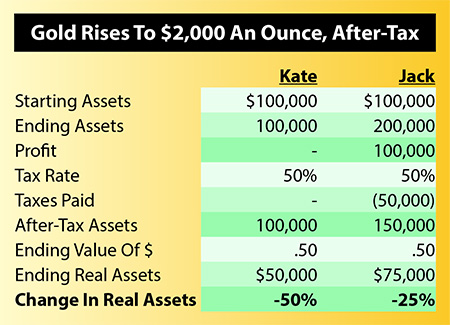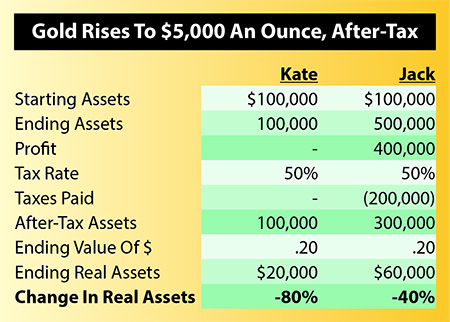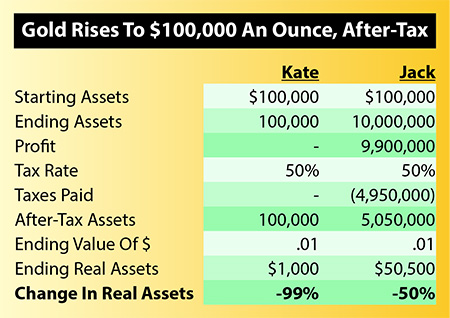
Reading Two:
Hidden Gold Taxes
The Golden Solution For Inflation
Many investors and financial commentators will tell you that there is no need to read a mini-course in order to learn how to turn inflation into wealth. They say the solution can be found in two words: BUY GOLD. (Or as some say: BUY SILVER.)
I like gold and silver. Gold or other precious metals should likely play a role in the portfolio of any investor who's concerned about high rates of inflation or the possibility of a currency meltdown. Depending on your situation and beliefs, there is a case for precious metals related investments composing at least 5% to 10% of your portfolio on the low-end, up to 60% or 70% of your assets on the high-end. The reason for precious metals is that in a time of crisis there two distinct, essential investment attributes that precious metals can deliver better than just about any other asset in the world.
Simply buying gold, however, is not a particularly good way to protect your net worth from inflation. Indeed, most gold and silver investors are unknowingly setting themselves up for a situation where the higher the rate of inflation – the more of their starting net worth ends up belonging to the government. To illustrate the problem with the conventional wisdom about gold, we will look at three different scenarios for gold which most gold investors would consider to be so attractive as to almost seem the stuff of fantasy: gold at $2,000 an ounce, $5,000 an ounce, and $100,000 an ounce.
$2,000 An Ounce Gold
In the first step of our illustration, we will consider a situation and how it affects the life savings of two investors. The situation is that 50% of the value of the dollar gets destroyed by inflation. This is not a radical assumption, as with modern symbolic or fiat currencies the value of money is always destroyed by inflation. The only question is one of speed, and if we look at the United States, 80% of the value of the dollar was destroyed by inflation between 1972 and 2007 as measured by official government statistics. For this illustration we will assume there is a smaller loss in value of the dollar, but that it happens much faster – because the US is in much worse shape right now than it was in 1972 in some key ways.
Kate is well educated, keeps up with the newspapers, and is concerned that the global financial crisis may get worse. So she liquidates her riskier investments, and to play it “safe”, moves her money into a $100,000 money market account.
For our illustration we will assume Kate's money is safe – but the value of her money is not protected. Inflation destroys 50% of the value of the dollar. Kate still has her full $100,000, but it will now only buy what $50,000 used to. Kate has lost 50% of the value of her investments to inflation (for simplicity, we’re leaving out assumptions on interim money market interest payments).
Jack also reads the mainstream media, but reads more widely as well, and believes that high inflation is the logical outcome of the financial crisis. Jack therefore takes his $100,000 and buys 100 ounces of gold at $1,000 an ounce (using round numbers for ease of illustration).
We will assume that gold performs exactly like many investors hope it will. That is, it acts like “real” money and maintains its purchasing power in inflation-adjusted terms. Now, if the dollar is only worth half of what it used to be, and gold does maintain its purchasing power, there is only one way for gold to do so, and that is for gold to sell for twice the number of dollars per ounce than it did before.
Therefore, gold goes from $1,000 an ounce to $2,000 an ounce. Those dollars are only worth fifty cents (in today's terms), so we multiply $2,000 times 50%, and we end up with $1,000. Jack's 100 ounces of gold at $2,000 each will buy exactly same amount of real consumption, of real goods and services, as gold used to buy for him at $1,000 an ounce. Some would say that this is an example of a perfectly successful inflation hedge, where gold has performed exactly like it is supposed to.
The powerful advantages of having your money in an inflation hedge when entering a period of substantial inflation, can be seen in the chart below, which compares what happened with Jack and Kate.

Adding Taxes
Through placing her money in what is conventionally considered one of the safest possible investments, during a time of high inflation, Kate has lost 50% of her net worth. This is terrible, of course, but at least she should be able to get a nice tax deduction out of this $50,000 loss. Except that when it comes time to fill in her tax return, she starts with $100,000 in her money market fund, and ends with $100,000 in principal in her money market fund. As far as the government is concerned -- there is no loss to be deducted. Kate still has every dollar she started with.
Jack decides to lock in his gains by selling his gold investment, redeploy most of his newfound wealth into some new investments, and maybe take a little out to reward himself for having made such a brilliant investment. When it comes time for Jack to fill in his tax return, it shows that he bought his gold for $100,000 and he sold it for $200,000, thereby generating a $100,000 profit. Effectively, the government looks at Jack's having dodged the its destruction of the value of the nation's money, and says “Great move Jack, you made a lot of money! Now give us our share.”
Even in bullion form, gold is currently taxed as a “collectible” in the US, with a 28% capital gains tax rate, or almost twice the long-term capital gains tax rate on investments that the financial industry and government prefer. We’ll call it 30% to allow for some state capital gains taxes, and to keep the numbers round. However, this rate is not sufficient to cover government spending, as the federal government is currently running enormous deficits, as are the states and municipalities (particularly when we take into account not only declining tax collections but the pension fund crisis). So it is reasonable to expect potentially much higher taxes in the not-too-distant future, both in the US and other nations. For illustration purposes then, we will assume a 50% future combined capital gains tax rate on gold – which is not unrealistically high from a historical perspective.
So for Jack, as shown in the chart below, paying a 50% tax rate on $100,000 in profits means $50,000 in required tax payments, and subtracting those taxes leaves Jack with $150,000.

Our final step is to adjust for a dollar being worth 50 cents, so we multiply $150,000 by 50%, and we find that Jack's net worth after-inflation and after-tax has fallen to $75,000. When it comes to what matters, the purchasing power of what our money will buy for us, then Jack didn’t double his money, instead he lost a quarter of what he started with. Jack just met what are known as “inflation taxes”. And they ran him over.
Turning Gold Into Lead
From a gold investor’s perspective, $2,000 an ounce gold may seem like a dream come true. And when we look at the results, $100,000 turning into $200,000, gold does look like a great investment. Until we remember that the reason gold went to $2,000 an ounce was because of inflation and we adjust our investment results for inflation. We break even. While not a net improvement relative to today, this outcome is highly desirable compared to what happened to Kate. Gold did indeed act as “real money”.
Unfortunately, we then run into one of the most deeply unfair and little understood aspects of inflation and investing in anticipation of inflation. Government fiscal policy destroys the value of our dollars. Government tax policy does not recognize what government fiscal policy does, and is blind to inflation. This blindness means that attempts to keep up with inflation generate very real and whopping tax payments, on what is from an economic perspective, imaginary income.
These taxes turn gold from a shimmering dream to a lead weight around our neck, and mean even a successful inflation hedge can lead to a devastating loss in net worth in after-tax and after-inflation terms.
So how do we deal with this lead weight of inflation taxes around our neck, trying to pull us down under the water? Does all of this mean that we just need to swim harder, to try to overcome taxes?
$5,000 An Ounce Gold
What if gold goes much higher than $2,000 an ounce? What if the dollar falls in value to twenty cents, and we assume that gold again performs as a perfect inflation hedge, and keeps its value? If the dollar drops to 1/5 its value, then the only way gold can keep up is to rise to 5X the dollar price, which means $5,000 an ounce gold.
First let's take a quick look at Kate. She still has $100,000 in her money market account, each of those dollars are now worth twenty cents, and the real value of Kate's “safe” investment is now down to $20,000. Kate has taken an 80% hit to the purchasing power of her net worth.
Meanwhile, Jack has enjoyed some fantastic investment results from his investment acumen. With 100 ounces of gold at $5,000 an ounce, Jack is now half way to being a millionaire!
Jack is ecstatic, at least until he tries to spend some of that half million dollars, and finds out what it will buy for him after he has paid his taxes. Let's repeat our chart from above, but with gold at $5,000 an ounce. When it's time to file his tax return, Jack now has a $400,000 profit to report. Jack therefore has to write the government a check for $200,000 for taxes due, leaving him with $300,000.

When we adjust for a dollar being worth twenty cents, then Jack's real after-inflation and after-tax net worth, what he can buy in today's dollar terms after paying the government, is down to $60,000.
The difference between gold going to $5,000 an ounce, and gold going to $2,000 an ounce, is that Jack loses more of his real net worth. Jack loses 40% of the purchasing power of his net worth at $5,000 an ounce instead of 25%.
The lead weight of inflation taxes is still around Jack's neck, heavier than ever, trying to pull him and his net worth deeper and deeper underwater. Perhaps Jack just isn't working hard enough, and he is going to have to swim like a wild man if he's going to stay afloat, as he will not only have to outpace inflation, but also inflation taxes.
$100,000 An Ounce Gold
Let's explore what happens if there is hyperinflation and a dollar becomes worth a penny. For Kate, the situation becomes even bleaker as the $100,000 in her money market account will now only buy what $1,000 used to. Kate has lost 99% of her net worth to inflation. Instead of a comfortable nest egg for retirement, she is impoverished, as are the many millions of others who were not prepared for hyperinflation.
If gold (or silver) serves as “real money”, and maintains its purchasing power even as paper money collapses, then to offset a dollar becoming worth 1/100th of what it used to, gold must climb to a dollar value that is 100X greater than what it was. So gold must go to $100,000 an ounce in order to maintain the same purchasing power as $1,000 an ounce gold today. Once again, we're assuming that gold acts as a perfect inflation hedge.
Jack's 100 ounces of gold are now worth a cool $10 million! Jack decides to sell his gold, lock-in his profits, and then start enjoying his new status as one of the ultra-wealthy.
As illustrated below, Jack sells his gold for a whopping $9.9 million profit. The government looks at his profit, and demands its $4,950,000 share. This still leaves Jack a millionaire multiple times over, as he has $5,050,000 in after-tax proceeds. Until we adjust for that technicality of a dollar only being worth a penny. And we find that instead of entering the ranks of the ultra-wealthy, Jack's net worth on an after-tax and after-inflation basis has fallen by almost 50%, from $100,000 to $50,500.

Jack has made one of the most brilliant market timing moves of all time. But the end result is that he loses almost half of his starting net worth in purchasing power terms. What's going on?
The Better You Do, The Worse You Do
Something seems seriously, seriously wrong here. Jack bets his net worth that inflation will skyrocket, and he buys an inflation hedge in the form of gold. His prediction comes true, a high rate of inflation does occur, and his gold investment does perform as a perfect inflation hedge. Yet the ending bottom-line is that Jack loses a big chunk of the value of his starting net worth. And the better that the gold performs and the more spectacular his returns -- the bigger the chunk of his real net worth that Jack loses.
This relationship is summarized in the chart below. When Jack earns a 100% profit -- he loses 25% of his net worth. When Jack earns a 400% profit -- he loses 40% of his net worth. When Jack earns a 9900% profit -- he loses 50% of his net worth.

A Pervasive & Difficult Problem
Inflation taxes are a basic fact of life which investors pay every year when there is inflation. These taxes are entirely real and are deeply painful when we look at the world in terms of what really matters – which is not the dollar amount of our savings, but what our savings will buy for us.
Real as they are, however, inflation taxes are not a line item on our tax returns. There's no box that we check that says go to form “30236 IT” to calculate our inflation taxes. There is no check we write that’s specifically made out to inflation taxes. There's never any discussion in the newspapers or magazines about how much money the average investor pays every year in inflation taxes.
So if almost nobody sees inflation taxes or talks about them – do they exist at all? This may be a good time for a pop quiz of sorts. If you are skeptical, the examples of Jack and Kate were kept very simple for a reason. Go back through the basic illustrations, and try to disprove them. Now, you can change how the price of gold moves relative to the destruction of the dollar, and you can change the tax rate – but there’s no room for anything else.
Do you agree that the numbers work? This “quiz” is self-graded, but your “score” could be essential for your future. Because if our future is one of high inflation, then whether and how you deal with inflation taxes may be one of the biggest determinants of your personal standard of living for decades to come.
Inflation taxes are irrefutable. Whenever you look at investment results on an after-tax and after-inflation basis in an environment of inflation, then inflation taxes make their ugly appearance.
However, while our illustration of Jack and Kate was not all that complicated to follow, the numbers involved are just sophisticated enough where they are rarely acknowledged in conventional personal finance. That combination of just a slight bit of sophistication, with never explicitly appearing on a tax return, means that likely in excess of 99% of the general population is blissfully unaware of inflation taxes.
Let me suggest that a big whopping tax that 99% of voters are blind to represents major opportunity for the government. An opportunity that has been fully taken advantage of by governments, even if the average senator, representative or member of parliament has no better understanding than the general public. Indeed, as covered in a later reading, when we take inflation taxes into account, then the real tax rate on investments in the US has historically been about 256% higher than the statutory rates.
History is bad enough, but as we illustrated with Jack and Kate, the higher the rate of inflation – the worse inflation taxes get. Staying ahead of inflation is hard enough. But even trying to tread water, to stay even with inflation, becomes extremely difficult when you have the lead weight of inflation taxes around your neck, pulling you down. The higher the rate of inflation, the heavier the weight of inflation taxes and the more difficult they are to overcome.
This is true for such traditional inflation hedges as gold and silver. It's also true for real estate. As it is true for stocks. Indeed, almost any traditional inflation hedge has difficulty in reaching the break-even point on an after-inflation and after-tax basis when we take into account the pervasive problem of hidden inflation taxes.
Financial Martial Arts
Well that was fairly bleak, but here's some good news. There is a unique course of instruction in how to protect yourself from inflation taxes. It’s free. You ‘re reading it right now.
Oh, we will thoroughly review methodologies for protecting ourselves from inflation, and even “Turning Inflation Into Wealth”. I do indeed have some uncommon solutions for you in this area, exactly as promised.
But, from a sophisticated financial perspective, beating inflation is actually the easy part. Beating inflation AND coming out ahead after paying inflation taxes is where it gets difficult. So difficult that very few traditional inflation fighting strategies can handle it. So difficult that the full extent of the problem is almost completely ignored by most financial advisors and writers.
In the readings ahead, you and I will explore how to defeat inflation taxes. To do this and have a chance of beating inflation taxes, we not only have to realize they exist, but we need to thoroughly understand our opponent.
Our opponent is an enormously powerful government that is deliberately blind to the effects of inflation. Government fiscal policy destroys the value of our money. Government tax policy is officially blind to inflation. So a crushing hidden tax is created that keeps us from maintaining the purchasing power of our savings, with our attempts to survive the deadly effects of inflation merely acting to increase government tax revenues.
As we will explore, the key to prospering in a world of inflation taxes is to understand that regardless of its strength, a blind opponent is ultimately a weak opponent. By focusing very closely on the intersection between taxes, net worth and inflation, we will discover how to turn inflation into gains in real wealth, to which the government is entirely blind. We will learn to reverse inflation taxes, so that instead of paying real taxes on imaginary gains, we are paying imaginary taxes on real gains. Entirely legally, with every cent of taxes due paid in full – because remember, inflation taxes don’t appear on your tax return, and neither does their reversal.
For further reading, a historical look at three case studies of inflation taxes & gold can be found at the link below:
http://danielamerman.com/articles/2012/GoldHisC.html
If A Friend Sent You This Link
If you found this reading because of a friend’s recommendation, then you should know that it is part of a free book on Turning Inflation Into Wealth. Sign-up below if you would like your own copy of this valuable educational resource, delivered via e-mail.
If there is something in this reading that you think a friend or colleague would find helpful, you are encouraged to send them a link to this webpage.
Please DO NOT use the form above to sign up friends without their permission. The book is intended only for people who want it, and have given their permission by signing up for it.
All readings in the book are the exclusive property of Daniel R. Amerman, CFA. Subscribers are allowed to print a single copy for their own usage. Any other copying of materials from these readings and reposting or reprinting elsewhere is strictly prohibited and constitutes a violation of international copyright law. If you would like to share these educational materials with others - please use a link to this website.







